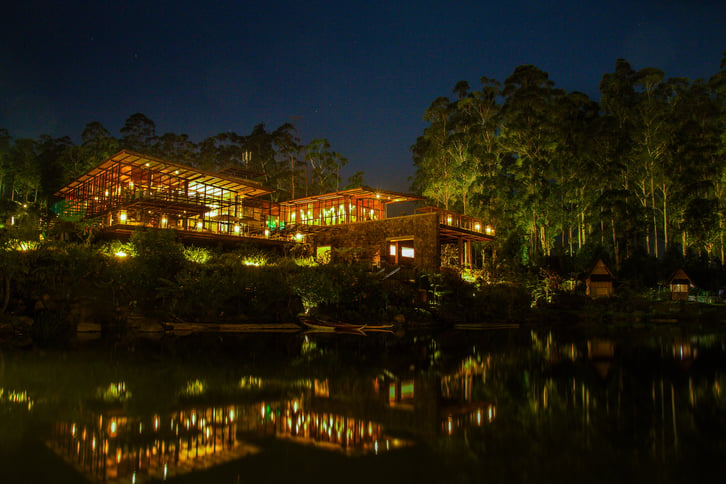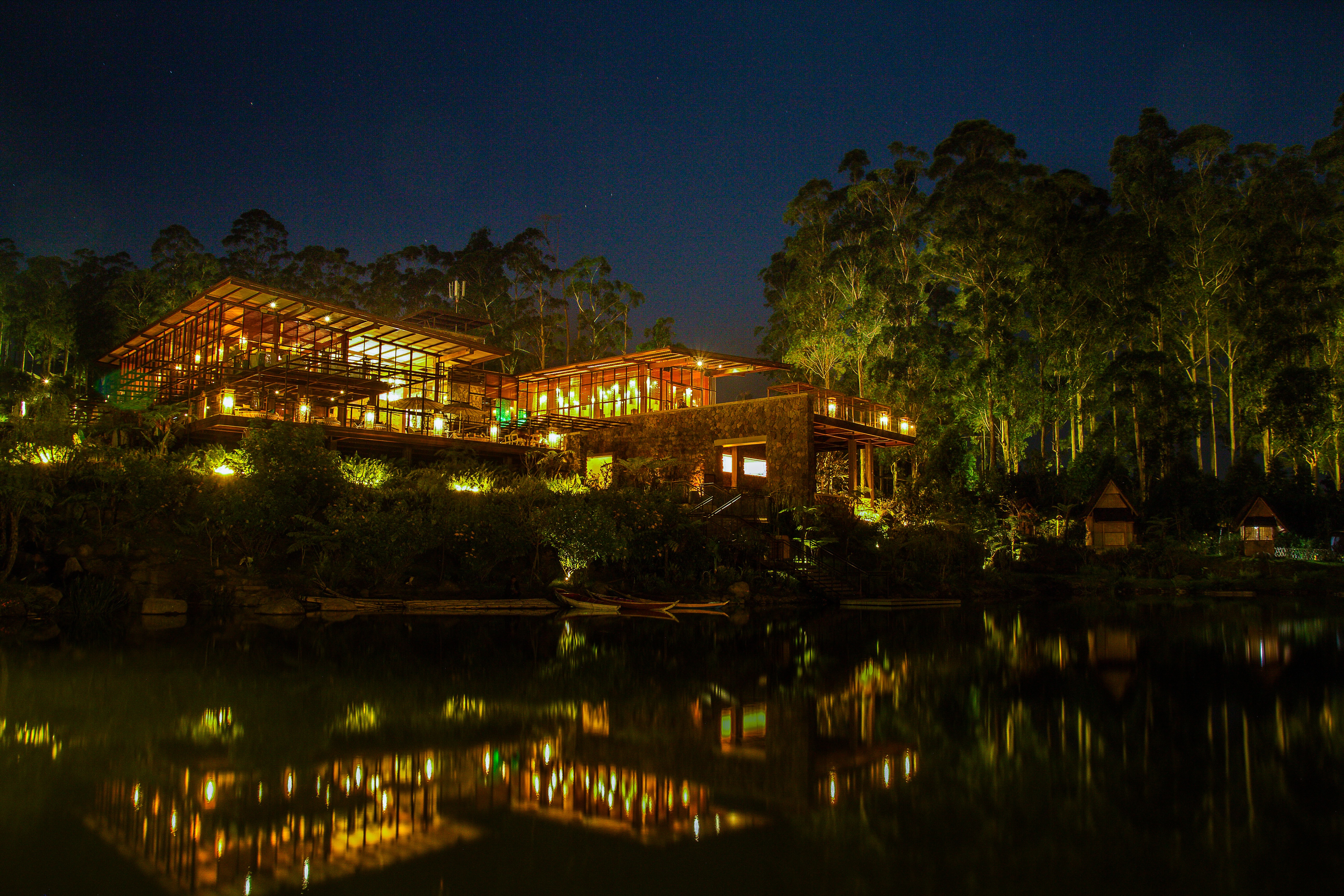Want to know how to install professional-looking landscape lighting? Sure, I can give you some landscape lighting tips. I’ll post a few of my best below.
But first, bear with me, because I just have to rant about what NOT to do with landscape lighting. It’s actually easy to demonstrate. All you have to do is get in your car and ride around after dark. I can almost guarantee that within a few blocks you’ll have passed case after case of really bad lighting installations.
Like the giant square box runway lights that just blast light at a building as if it were daylight, doing nothing to highlight the architecture or evoke a mood.
Or the residence where somebody bought bullet lights and aimed them at a shrub, and it looks like what Moses saw on Mount Horeb: a single bush all alight with nothing but harsh shadows all around.
Or the facade of a house that has a bright, bright light in one spot right next to a patch of blackness so dark the devil could be hiding there. It’s jarring. When will people learn that you can’t just go buy lights and point them at things and expect it to come out looking good?
Now that I’ve got that off my chest, let’s talk about how to do landscape lighting right.
Landscape Lighting 101: What Every Landscape Lighting Professional Ought To Know (But Many Don’t)
There’s a science to landscape lighting, and an art to it. In fact, I like to think of landscape lighting as a combination of engineering and artistic painting. You have to have the mind of a mathematician and the eye of an artist. Both require finesse.
To do lighting well you need to first understand how the human eye and mind work. It’s important to understand how human beings perceive things, and how lighting levels, color temperatures and contrast impact human emotion as well as human locomotion. (And in case you’re wondering, Joe Schmuck with a truck probably isn’t thinking about these things. That explains a lot.)
.jpeg?width=320&height=240&name=IMG_0292%20(1).jpeg)
In addition to having a modicum of aesthetic appreciation, you also have to understand voltage drop, electrical codes, proper mounting, maintenance, and long term ROI. I”m not going to cover all these things here because it would take a book, but in my mind any competent landscape lighting professional should be well versed in these skills and concepts before hanging out a shingle.
Got these down pat? Great! Let’s move on to the tips. Here are some landscape lighting pointers to help you create a drop-dead gorgeous installation.
Landscape Lighting Fixture and Material Selection
First, let’s talk hardware. Your choice of fixture is very important because a poor quality fixture (or the right fixture in the wrong location) will look terrible in short order, and will often create more headaches than it is worth. Here are some things to consider when shopping for outdoor lighting fixtures:
Choose High Quality Fixtures
These days, there are literally dozens of landscape lighting manufacturers who between them offer hundreds if not thousands of fixture models.But you won’t find them in a big box store. Do yourself a favor and go to a place that sells high quality commercial fixtures, instead. Here are some brands I can personally recommend:
- KIM - As far as I am concerned, KIM is the granddaddy of outdoor lighting. KIM is our top choice for long term value in commercial landscape lighting installations, but they are also an excellent choice for residential use. I personally have installations of KIM fixtures that have been there 40 years and are still going strong.
- Unique Lighting - This company specializes in low voltage lighting and has an innovative range of 12 and 24 volt fixtures as well as wireless lighting accessories.
- FX Luminaire – A subsidiary of Hunter Irrigation, this company has done a great job with controls, integration, and quality fixtures.
- Kichler – Although we personally don’t use it in installations for clients, this is a good quality brand for residential installations.
- CopperMoon - And of course the list would not be complete without this good Georgia-based company. They’re good folks, and they offer a nice selection of quality, USA-made copper fixtures.
There are plenty of other outdoor lighting companies, but when it comes to off-the-shelf fixtures to consider in the low voltage line you can’t go wrong limiting your search to these.
Select The Right Fixture Materials For Your Site
Regardless of which manufacturer you go with, be selective about your fixture materials. You want something that will hold up to conditions in your area and stay looking nice for years.
My preference is always copper, but brass and bronze can do well, too. If you really need a budget option, cast aluminum is very cost effective for non-coastal environments. However, don’t use it if you live along the coast; it oxidizes in salt air and will look terrible in short order. If you do go with aluminum make sure it is powder coated for a long lasting finish.
I am not a fan of composites or plastics in outdoor lighting fixtures. They don’t age well and typically look pretty horrendous after just a few years. And by all means avoid steel alloys, unless you really like the look of rust.
Make The Right Connections
While we’re talking about fixtures, it’s worth mentioning that a lighting system is only as good as the integrity of its electrical connections.
Remember, these puppies are going to be lying in the dirt. You want the majority of the surface area of the wire to have contact with the surface area of the next wire. That’s why we don’t think much of the clamp-on puncture type connectors. These offer minimal wire-to-wire connection, which over time leads to less than perfect performance. Instead, we use watertight sealed connectors for a true lug-to-lug water tight connection that resists oxidation over the long haul. It’s like the difference between a lean-in shoulder hug versus a full-body embrace—you know which one is more bonding.

Professional Landscape Lighting Techniques
Once you’ve got the basic know-how down, and have your fixtures in hand, it’s time to consider what to do with them. This is the artistry part of it, and it is what ultimately creates the magic.
Here are some landscape lighting techniques we use to improve the nighttime safety and aesthetic appeal of our clients’ properties:
- Avoid dramatic changes in brightness levels. The human eye and brain don’t deal well with abrupt brightness changes. When these occur along a pathway or walking surface it’s difficult for the eyes to adjust fast enough, and causes confusion, discomfort, and unease. Instead, aim for even, consistent illumination to avoid trip hazards and provide a pleasant, comforting nighttime experience.
- Layer and transition your lighting. Layering light with increasing or decreasing levels of brightness allows the eye to move through space without creating eye fatigue. It softens borders and creates a pleasant, flowing transition from one space to the next, rather than a harsh delineation. For border areas, we like to flow the light levels up. We typically use softer light in the foreground, starting with low foot candles at the perimeter and gradually increasing light levels as we move towards the back in multiple layers.
- Use bright spotlights sparingly. A hot, brightly lit feature surrounded by darkness creates a rather shocking effect that is less than pleasant. The only things we like to really heat up that way are flags on a pole, and sometimes statuary—very little else.
- Don’t reveal the source, just the impact. This is one of the marks of a pro. You never want light glaring into someone’s eyes, especially pedestrians and drivers. They should just experience the impact of the light on the environment.
- Use light in varied and creative ways. There are many ways to use and direct light, including uplighting, downlighting, spotlighting, and silhouetting. Use these to enhance existing features of your landscape. For instance, a pathway can be gently lit with downlighting, taking the light through tree branches in a technique called moonlighting that casts beautiful shadows on the ground. At the terminus of a walkway you can uplight statuary or trees for a striking effect. Trees with textured bark or beautiful trunks (such as crepe myrtles) lend themselves well to this technique. You can also make a landscape area seem deeper, or foreshorten it based on cadences and whether it gets lighter or darker.
- Use shadows, not just light. It’s the subtle shadows we create with lighting that transform a nighttime landscape into something amazing. Remember there are two kinds of shadows: cast shadows and form shadows (seen on the “shadow side” of an object.) Play your lighting over architectural and landscape features to create interesting and pleasing effects with both.
Looking For Professional Landscape Lighting?
Hopefully these tips will help you to avoid the worst of the common landscape lighting pitfalls and create a beautiful nighttime landscape on your property. But should you decide you’d rather just sit back and enjoy your nightscape without getting your hands in the dirt, by all means give us a call, or request a quote for landscape lighting installation. We’ll be happy to assist!
1 Oct 2024




